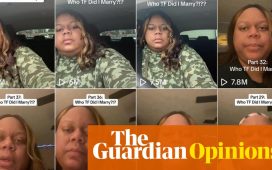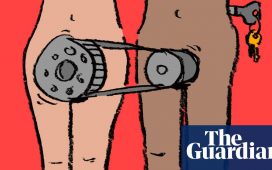Yasmin Benoit realised she was asexual around the time her peers in Reading figured out they weren’t. “Everyone seems pretty asexual until puberty hits and then they aren’t. But I didn’t feel the same way. I realised something was up,” she recalls.
But when the then-teenager came out as asexual, no one believed her. “They were, like: ‘You don’t look asexual, you’re probably just insecure, or you must have got molested or you must be gay… Maybe you’re a psychopath and can’t form proper connections with people.’”
Everyone had a theory about what was “wrong” with Benoit; no one accepted the simple fact that, by nature, she didn’t feel sexual attraction towards others. And she’s not alone. Today, as well as being a fashion model, the poised 24-year-old is the world’s most prominent activist for asexuality, an orientation estimated to apply to 1% of the global population, although some think the number is higher.
“I don’t want to have sex with anybody and I probably won’t ever have sex,” says Benoit over Zoom, although she does explain that the key point here is sexual relations with others: she does masturbate.
Benoit is determined to ensure other asexual (or “ace”) people don’t feel broken or alone in a world in which lust and desire pulsate through our entire culture. “Our society is increasingly hyper-sexualised,” she says, “and that can make it particularly alienating for asexual people who don’t have those feelings, or don’t want to live that life.”
The asexuality movement is young and fast-growing, and it recently received a notable boost. Last September saw the release of Ace, a critically acclaimed book by asexual journalist Angela Chen. It illuminates the myriad shades of asexuality via a series of real-life profiles. “Instead of getting bogged down in definitions, people can read those stories and think: does that resonate with my experience?” says Chen, 29, who is based in Brooklyn.
For too long such experiences have not been acknowledged: asexuality has sometimes been dubbed the “forgotten” or “invisible” orientation owing to its lack of public prominence. Until recently it was deemed a medical issue by the US’s Diagnostic and Statistical Manual of Mental Disorders – which added an exception in 2013 to state that asexuals do not have a desire disorder – and many continue to erroneously dismiss it as an affliction.
It has also been labelled “the world’s first internet orientation,” implying that people who feel this way have only existed since the advent of the internet – and suggesting it’s a fad embraced by pink-haired teens on Tumblr, but not applicable in the real world. Nonetheless, the internet has been an anchor for the modern asexuality crusade, which began in 2000 when David Jay, a San Francisco college student, started a website to connect with others (when he’d looked up “asexuality” all he’d found were “papers about plant biology and amoebas”, he says). It attracted thousands of hits and he then launched the Asexual Visibility and Education Network (AVEN), which remains the biggest asexuality platform, with 120,000 members today. Tight-knit communities have since sprouted on Twitter, Tumblr, Reddit and Discord, and have flourished offline, too.
Jay has been joined by a spirited collective of younger activists who give talks, write books, host podcasts and run YouTube channels. They’re showing it’s possible to live a fulfilling life without sex and, although they’re a small minority, they have plenty to teach the rest of society. Such as about how allosexuals – people who do experience sexual attraction – conflate sex, romance and intimacy, yet could benefit from teasing these things apart. Or about how sexual partnerships are automatically ranked higher in the social totem pole than platonic ones – a sentiment captured in phrases such as “just friends” and enshrined in health-insurance and other laws – even though friendships can be more meaningful.

Photograph: Winni Wintermeyer/The Observer
Without sex clouding their vision, aces say they are coming from a unique position of clarity. As Chen puts it: “Asexuality is not something that’s so separate, it’s a lens that you can use to evaluate your own life, no matter how you identify, whatever your sexual orientation is.”
One of the biggest hurdles activists face is explaining what asexuality is. It can get knotty because sexual and romantic attraction are different things. And while many aces, such as Benoit, are also aromantic, meaning they have no interest in romantic relationships, others feel differently. Chen, for example, is biromantic (attracted romantically to both genders) and has a long-term boyfriend with whom she has sex. She says she has sex with her partner for emotional reasons only – to feel close to him – but adds: “I could go the rest of my life being celibate and I would be perfectly happy.”
“For me, asexuality is not about how much sex someone has, but the role sexuality plays in how they experience life,” says Chen. “I never ever think about if someone’s sexually attractive.”
Daniel Walker, a 24-year-old from the East Midlands who hosts YouTube channel Slice of Ace, is asexual and homoromantic. He is physically affectionate with his boyfriend and says that “externally, my relationship looks pretty similar to any other gay relationship”. While he has zero “internal drive to have sex”, he says he is “comfortable” engaging in it as part of his relationship.
If you remove sexual desire, what’s the difference between romance and an intense platonic friendship? Research suggests key differences, says Chen, with romantic attraction leaving individuals wanting to change their life for their partner, being infatuated with them and becoming possessive.
Thinking about these ideas is a useful exercise for all of us, yet they also add confusion to an orientation that’s poorly understood to begin with. “If I come out as gay, people instantly know what that means; whereas if I come out as asexual, nine times out of 10, I’ll have to explain,” says Walker.
Other challenges abound. As Chen points out, because the movement is young, most “out” aces are young people not yet in positions of power. And the nature of their orientation – defined by what they don’t like rather than what they do – can mean aces don’t shout as loudly as others. “You don’t tend to go around saying: ‘You know what I don’t like? This film!’” says Walker, by way of analogy.
What these activists do is emphasise that it’s OK not to have sex – yet they are careful not to be misconstrued as promoting celibacy or condemning sex-positivity, neither of which are goals. And while they are increasingly embraced by the queer community, the relationship can be testy. “Conversations surrounding the wider LGBTQ+ community have become very sex-focused, and there’s a question of where asexuality fits into that,” says Benoit. “People in the community who aren’t ace-inclusive think asexual people are anti-sex and we’re going to come in and ruin it by telling people to stop holding hands and kissing.”
When many people envisage an “asexual” they picture a nerdy, androgynous white male – think Sheldon Cooper from The Big Bang Theory – but as a black female model, Benoit is taking on these stereotypes. She has more than 33,000 Instagram followers and her shoots, often for lingerie brands, can be racy – being ace doesn’t mean swapping fishnets for nun’s habits. (When I ask about the ironic interplay between being asexual and selling desire through modelling, she replies matter-of-factly: “Whatever people find sexy is their business; I just make sure the bra looks pretty.”)
Benoit was spurred into activism because she couldn’t relate to aces in the public eye. “I thought: ‘I can’t sit here and complain that I don’t see black asexual people if I’m black and asexual and I’m not really talking about it.’” She is, she says, a person of “direct action”: as well as co-founding International Asexuality Day, which will be held for the first time on 6 April, she set up an ace bar during London Pride, gives university talks and runs the social-media account This is What an Asexual Looks Like, which celebrates aces of different shapes and skin tones.

Her work resonates with other activists of colour, such as Pennsylvanian Marshall John Blount. “From my experience, when people see a black guy who’s asexual they are shocked because often [black men] get stereotyped as being hyper-sexualised,” says Blount, but adds: “There’s a growing number of black and brown aces and the more vocal we get, the more people are going to see we exist.”
Even beyond cultivating the white-nerd cliché, pop culture has a patchy track record with asexuality. Its nadir was a 2012 episode of TV medical drama House, in which a patient’s asexuality is declared an illness. Since then things have improved. In 2016 the writers’ team for animated sitcom BoJack Horseman contacted AVEN when researching the character of Todd Chavez, a bestubbled hoodie-wearing skateboarder. The sensitive portrayal of Chavez’s asexuality resonated with viewers; a couple of activists I speak to know of people who came out after seeing themselves in Chavez.
More recently there have been minor ace characters in British shows Sex Education and Emmerdale, yet such murmurings do not a revolution make. Sarah Costello is an LA-based aspiring TV writer and the co-host of popular ace podcast Sounds Fake But Okay. She concedes ace representation in pop culture has become “a little bit better”, but says it’s “asexuality 101,” like an education special, without exploring characters’ rich lives. “There’s this thought that stories are less interesting if they don’t include romance or sex, but we can tell interesting stories about our lives without people having to mash their faces together,” she says.
“If it’s natural to have a romantic subplot, then sure – but don’t force it in if it doesn’t make sense.”
For an absorbing ace story you need only look to Jay, the asexual, aromantic founder of AVEN. In 2017, he and a heterosexual couple created a three-parent family; they are raising a baby girl together. Recognising you can have intimate, life-altering relationships without sex or romance is the next frontier, he says. Even if allosexuals accept platonic partnerships can be fulfilling in the abstract, we’re often not sure how that actually looks. Aces show us. “I can never be romantic and sexual, and I have an amazing family; we highlight these other paths to human connection,” says Jay.
He’s optimistic about the future given the prevalence and energy of younger aces, and thinks that, in time, dating and sex will no longer be seen as the only valid paths to intimacy – that it will become more common to, say, raise a child with your best friend, whether or not you’re asexual.
This could have a momentous impact on people of all orientations. By showing that a life filled with close friendships can be meaningful and satisfying – and enough – aces promise to allay one of humankind’s greatest fears: that of being alone. Being sexually and romantically unattached does not, in itself, sentence you to a lifetime of dissatisfaction; not everyone needs to find a mate.
“There’s this deep fear of loneliness if you don’t play the game of engaging in dating and sexuality – and ace people embody and diffuse that fear,” says Jay. We have much to learn. May the 1% open our minds and lead the way.














